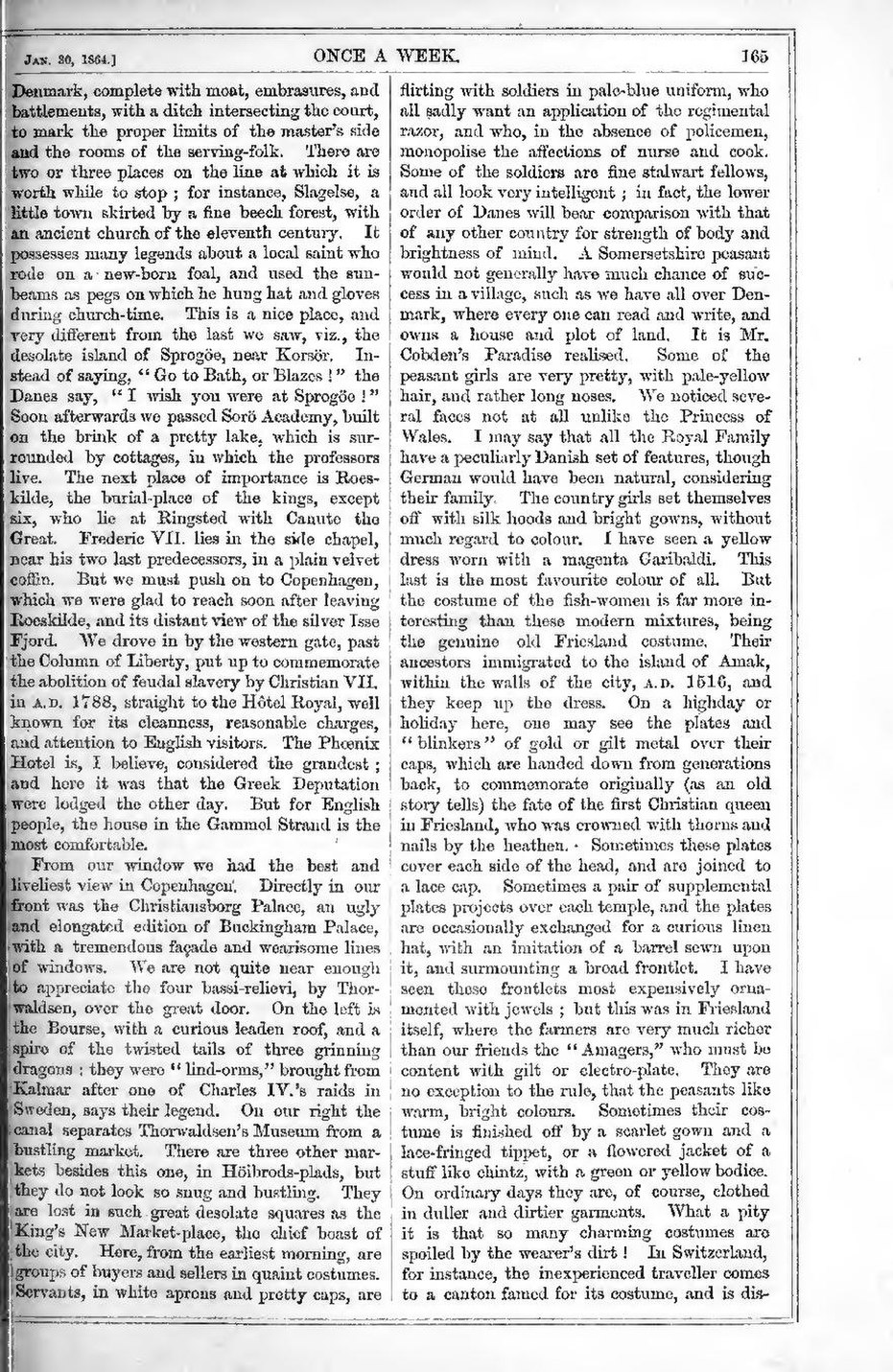Denmark, complete with moat, embrasures, and battlements, with a ditch intersecting the court, to mark the proper limits of the master’s side and the rooms of the serving-folk. There are two or three places on the line at which it is worth while to stop; for instance, Slagelse, a little town skirted by a fine beech forest, with an ancient church of the eleventh century. It possesses many legends about a local saint who rode on a new-born foal, and used the sunbeams as pegs on which he hung hat and gloves during church-time. This is a nice place, and very different from the last we saw, viz., the desolate island of Sprogöe, near Korsör. Instead of saying, “Go to Bath, or Blazes!” the Danes say, “I wish you were at Sprogöe!” Soon afterwards we passed Sorö Academy, built on the brink of a pretty lake, which is surrounded by cottages, in which the professors live. The next place of importance is Roeskilde, the burial-place of the kings, except six, who lie at Ringsted with Canute the Great. Frederic VII. lies in the side chapel, near his two last predecessors, in a plain velvet coffin. But we must push on to Copenhagen, which we were glad to reach soon after leaving Roeskilde, and its distant view of the silver Isse Fjord. We drove in by the western gate, past the Column of Liberty, put up to commemorate the abolition of feudal slavery by Christian VII. in A.D.. 1788, straight to the Hôtel Royal, well known for its cleanness, reasonable charges, and attention to English visitors. The Phœnix Hotel is, I believe, considered the grandest; and here it was that the Greek Deputation were lodged the other day. But for English people, the house in the Gammol Strand is the most comfortable.
From our window we had the best and liveliest view in Copenhagen. Directly in our front was the Christiansborg Palace, an ugly and elongated edition of Buckingham Palace, with a tremendous façade and wearisome lines bf windows. We are not quite near enough to appreciate the four bassi-relievi, by Thorwaldsen, over the great door. On the left is the Bourse, with a curious leaden roof, and a spire of the twisted tails of three grinning dragons: they were “lind-orms,” brought from Kalmar after one of Charles IV.’s raids in Sweden, says their legend. On our night the canal separates Thorwaldsen’s Museum from a bustling market. There are three other markets besides this one, in Höibrods-plads, but they do not look so snug and bustling. They are lost in such great desolate squares as the King’s New Market-place, the chief boast of the city. Here, from the earliest morning, are groups of buyers and sellers in quaint costumes. Servants, in white aprons and pretty caps, are flirting with soldiers in pale-blue uniform, who all sadly want an application of the regimental razor, and who, in the absence of policemen, monopolise the affections of nurse and cook. Some of the soldiers are fine stalwart fellows, and all look very intelligent; in fact, the lower order of Danes will bear comparison with that of any other country for strength of body and brightness of mind. A Somersetshire peasant would not generally have much chance of success in a village, such as we have all over Denmark, where every one can read and write, and owns a house and plot of land, It is Mr. Cobden’s Paradise realised. Some of the peasant girls are very pretty, with pale-yellow hair, and rather long noses. We noticed several faces not at all unlike the Princess of Wales. I may say that all the Royal Family have a peculiarly Danish set of features, though German would have been natural, considering their family. The country girls set themselves off with silk hoods and bright gowns, without much regard to colour. I have seen a yellow dress worn with a magenta Garibaldi, This last is the most favourite colour of all. But the costume of the fish-women is far more interesting than these modern mixtures, being the genuine old Friesland costume. Their ancestors immigrated to the island of Amak, within the walls of the city, A.D. 1516, and they keep up the dress. On a highday or holiday here, one may see the plates and “blinkers” of gold or gilt metal over their caps, which are handed down from generations back, to commemorate originally (as an old story tells) the fate of the first Christian queen in Friesland, who was crowned with thorns and nails by the heathen. Sometimes these plates cover each side of the head, and are joined to a lace cap. Sometimes a pair of supplemental plates projects over each temple, and the plates are occasionally exchanged for a curious linen hat, with an imitation of a barrel sewn upon it, and surmounting a broad frontlet. I have seen these frontlets most expensively ornamented with jewels; but this was in Friesland itself, where the farmers are very much richer than our friends the “Amagers,” who must be content with gilt or electro-plate. They are no exception to the rule, that the peasants like warm, bright colours. Sometimes their costume is finished off by a scarlet gown and a lace-fringed tippet, or a flowered jacket of a stuff like chintz, with a green or yellow bodice. On ordinary days they are, of course, clothed in duller and dirtier garments. What a pity it is that so many charming costumes are spoiled by the wearer’s dirt! In Switzerland, for instance, the inexperienced traveller comes to a canton famed for its costume, and is dis-